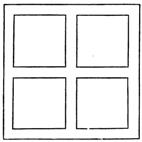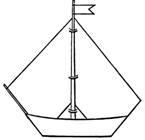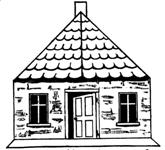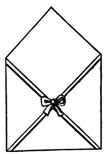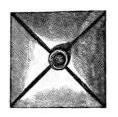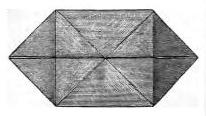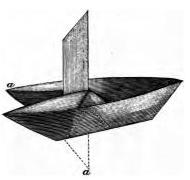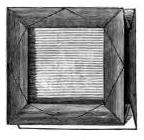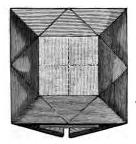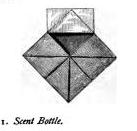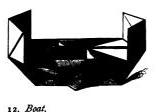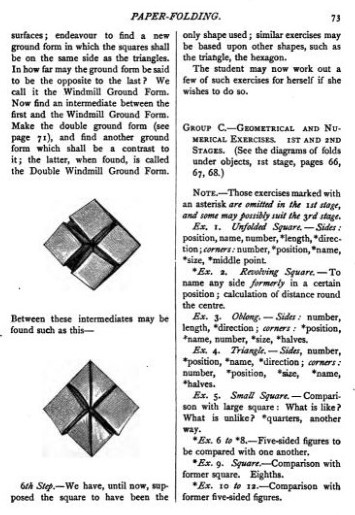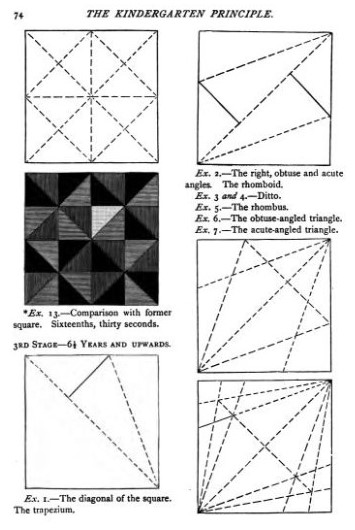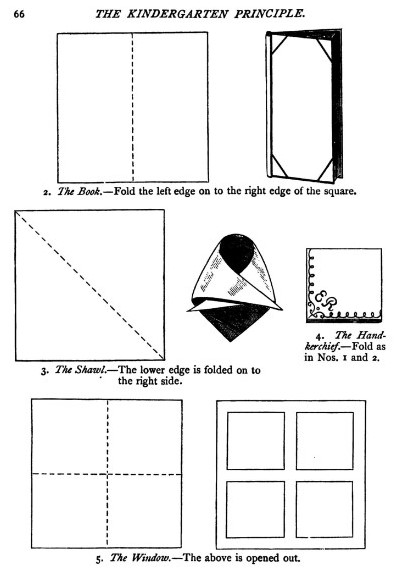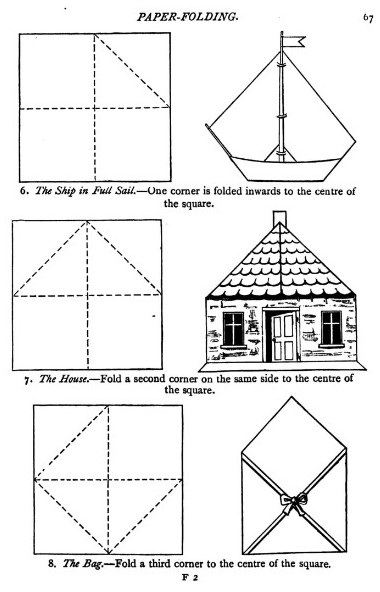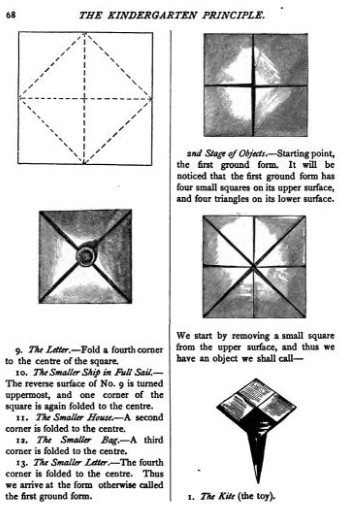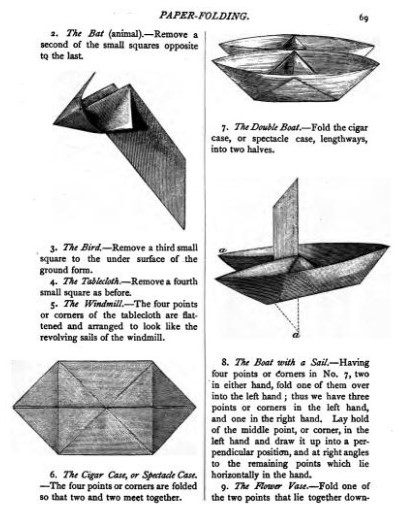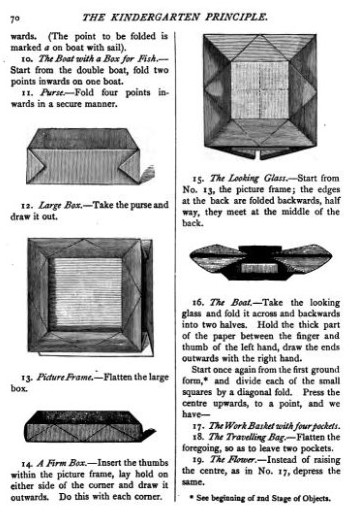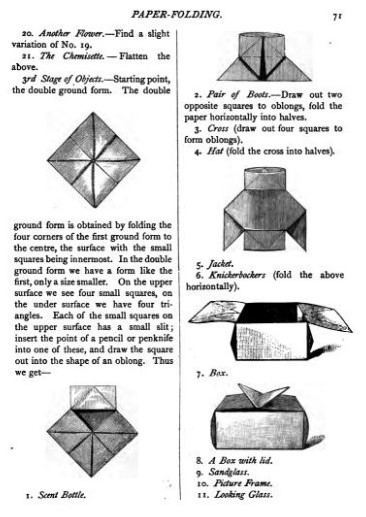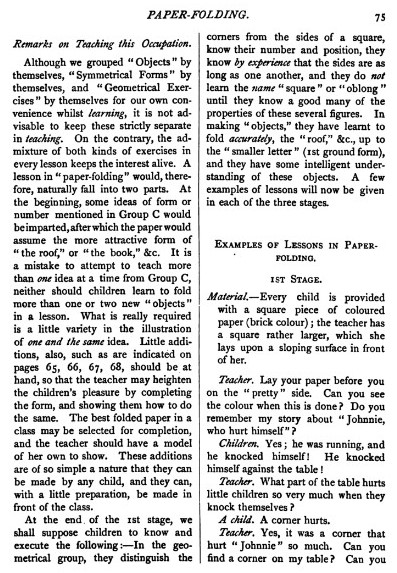| The Public Paperfolding History Project
Last updated 8/11/2025 x |
|||||||
| The Kindergarten Principle by Mary J Lyschinska, 1880 | |||||||
| 'The
Kindergarten Principle' by Mary J Lyschinska was
published in London in 1880 by Wm Isbister Ltd. It
contains a section on Paper-Folding in a chapter entitled
'A Few Occupations Explained and Applied'. None of the
other occupations involving paperfolding are explained in
the work. There are also two sample lessons using
paperfolding. The work contains 3D drawings of many of the Folds of Life mentioned in the text, but the folding instructions are in words. The work also explains how to develop the 'Windmill Ground Form' from the Double Blintz Basic Form, in two different ways, and the 'Double Windmill Ground Form' from the Triple Blintz Basic Form (although no designs are developed from the latter base). In the Preface Lyschinska states that she is a pupil, and friend, of Henrietta Schrader (nee Breyman). The opening sentence of the Introduction comment that 'The educational public in England are still inclined to regard a long list of games and occupations as the chief addition which Frederick Froebel has made to the cause of education', a situation which the work sets out to remedy. A full copy of the work can be accessed online here. The main pages from the Paper-Folding section are reproduced at the foot of this page. **********
**********
**********
********** Analysis Familiar Objects - Folds of Life 46 designs are mentioned in the text, only some of which are illustrated. They are divided into three groups, or stages of objects, very simple and single blintz designs, double blintz basic fold / windmill base designs, and triple blintz basic fold designs. 1st Stage of Objects (very simple and single blintz designs) - Simple Folds of Life 1, The Roof (in which holes are cut to facilitate the addition of chimneys)
********** 2, The Book
********** 3, The Shawl
********** 4, The Handkerchief
********** 5, The Window
********** 6, The Ship in Full Sail
********** 7, The House
********** 8, The Bag
********** 9, The Letter
********** 10, The Smaller Ship in Full Sail (not illustrated) ********** 12, The Smaller Bag (not illustrated) ********** 13, The Smaller Letter (not illustrated) ********** 2nd Stage of Objects This sequence of designs begins with The Double Blintz Basic Form. One of the four square flaps is taken to the other side to produce: 1, The Kite
********** A second is taken to the other side to produce: 2, The Bat
********** A third to produce: 3, The Bird (not illustrated) but clearly The Cocotte / Pajarita) ********** A fourth to produce: 4, The Tablecloth (not illustrated) which then acts as the base for the development of the other designs. ********** 5, The Windmill (not illustrated) ********** 6, The Cigar Case or Spectacle Case
********** 7, The Double Boat
********** 8, The Boat with Sail
********** 9, The Flower Vase (not illustrated) - The Vase ********** 10, The Boat with a Box for Fish (not illustrated) - The Boat with Fishbox ********** 11, Purse (not illustrated) - The Portfolio ********** 12, Large Box - The Open Box
********** 13, Picture Frame - The Frame
********** 14, A Firm Box - The Solid Box
********** 15, The Looking Glass - The Mirror
********** 16, The Boat - The Gondola
********** Atb this point the sequence starts again from the first ground form (ie The Double Blintz Basic Form) 17, The Work Basket with Four Pockets (not illustrated) - The Salt Cellar ********** 18, The Travelling Bag (not illustrated) - The Travel Bag) ********** 19, The Flower (not illustrated) ********** 20, Another Flower (not illustrated) ********** 21, The Chemisette (not illustrated) - The Collar ********** 3rd Stage of Objects - designs from The Triple Blintz Basic Form 1, The Scent Bottle
********** 2, The Pair of Boots
********** 3, The Cross (not illustrated) ********** 4, Hat (the Cross folded in half) (not illustrated) ********** 5, Jacket (the Jacket from the Suit of Clothes)
********** 6, Knickerbockers (the Jacket folded in half) (not illustrated) ********** 7, Box - The Junk Box
********** 8, A Box with Lid - The Catherine of Cleves Box Misplaced in the series
********** 9, Sandglass (not illustrated) ********** 10, Picture Frame (not illustrated) ********** 11, Looking Glass (not illustrated) ********** 12, Boat - The Chinese Junk
********** Symmetrical Forms - Folds of Beauty There is a brief mention of this type of design on pages 72 and 73 but no examples are illustrated. Instead the author concentrates on explaining how further groundforms from which Folds of Beauty are developed can be created. The first ground form is The Double Blintz Basic Form. From this the Windmill Ground Form is developed by opening out each of the triangular flaps in turn and reverse folding them inwards underneath the square flaps. The author then says 'Now find an intermediate between the first and the Windmill Ground Form. The double ground form is The Triple Blintz Basic Form. From this is developed the Double Windmill Ground Form by thge same process as the Windmill Ground Form was developed from The Double Blintz Basic Form. The aiuthor states that 'similar exercises may be based on other shapes such as the triangle, the hexagon.'
********** Geometrical and Numerical Exercises - Folds of Knowledge There is brief mention of these forms and exercises on pages 73 and 74 but the theme is not developed in detail.
********** Source Pages
********** |
|||||||







